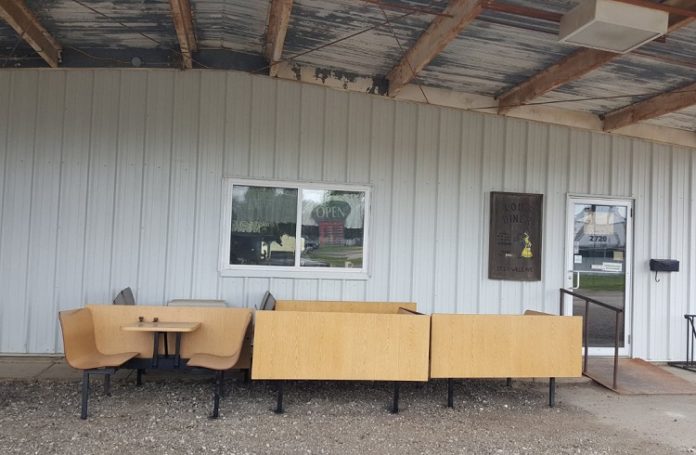

Since March 17, when Iowa Gov. Kim Reynolds proclaimed a State of Public Health Disaster Emergency that effectively locked down large parts of the state economy, foot traffic has fallen to zero in many local businesses deemed inessential under the governor’s order.
So what better time to upgrade a small business from the bottom up and install new flooring?
At least two service businesses in Perry — one offering food services and the other personal-care services — are filling the hiatus by laying down new linoleum: Lou’s Diner at 2720 Willis Ave. and Paradise Nails at 530 First Ave.
Each was lately seen with its inside seating outside, from the padded recliners of the nail salon to the formica fixtures of the short-order restaurant.
When dining in is again permitted in Dallas County, Lou’s Diner will look spiffy with new flooring. The diner was awarded a $13,236 Iowa Small Business Relief Grant in April through the Iowa Economic Development Authority.
Reynolds announced April 27 the relaxation of restrictions in 77 Iowa counties, allowing some businesses to resume trade May 1 and with others set to follow suit May 15. Dallas County’s restrictions have not been relaxed.
A statement by the Iowa Medical Society, the state’s largest physician organization, urged Iowans to continue limiting travel outside the home and following health guidelines in order to reduce the risk that increased social interactions will cause a spike in infections.
“A sudden influx in social interactions is all but certain to cause a spike in new COVID-19 patients and potentially overwhelm our healthcare system,” the statement said. “No area of our state is immune from these concerns. Until an effective treatment protocol is identified or a vaccine is discovered, we must accept that we will not be able to return to the normal routines we enjoyed just a few months ago.”
Even after May 1 and May 15, the “normal routines” will not quickly return. Reynold’s April 27 proclamation orders restaurants to adhere to the following mandatory requirements for the foreseeable future:
- Limit indoor and outdoor seating capacity to 50 percent of normal operating capacity.
- Limit group size to no more than six people.
- Arrange seating to provide a minimum of six feet between tables.
- Disallow customer self-service of food or beverages, including buffets and salad bars.
- Implement reasonable measures to ensure social distancing of employees and customers, increased hygiene practices, and other public health measures to reduce the risk of transmission of COVID-19.
Additionally, the Iowa Department of Inspections and Appeals and the Iowa Department of Public Health strongly recommend that all restaurants adhere to the following guidance:
- To the extent possible, eliminate seating at bars within restaurants.
- Eliminate entertainment operations or activities.
- Serve alcohol to a guest only if the guest is also ordering and consuming food items.
- Disinfect tables and chairs after each customer use.
- Clean and sanitize table condiments, reusable menus, digital ordering devices, check presenters, pens, napkin dispensers, salt and pepper shakers, and other commonly-touched items between each customer use.
- Use pre-wrapped silverware and eliminate table presets including table tents, menus, salt and pepper shakers, napkin dispensers, and condiments.
- Eliminate refilling customer beverages from common containers, such as pitchers.
- Discard single-use or paper articles, such as paper menus, after each use.
- Create and implement an enhanced cleaning/sanitizing schedule for all food contact surfaces, and cleaning/disinfecting of non-food contact surfaces.
- Disinfect commonly-touched surfaces throughout entire facility (both front and back-of-house) such as door handles, credit card machines, bathrooms, etc., at least once every hour.
- To the extent possible, on-premises dining should be by reservation only and customers should be screened upon reservation and arrival as to whether anyone in the party is positive, has any symptoms, is under quarantine, or has been exposed to COVID-19.
- Post signage on entrance door that no one with a fever or symptoms of COVID-19 will be permitted in the restaurant.
- Screen all employees each shift before entering the facility for symptoms — such as a fever of 100°F or higher, cough, shortness of breath, runny or stuffy nose, sore throat, muscle aches, fatigue, diarrhea, or vomiting. Immediately exclude anyone with symptoms from entering.
- Where possible, workstations should be staggered to avoid employees standing directly opposite one another or next to each other, and maintain six feet of social distance.
- Require employees with direct customer contact to wear cloth or other mask that is laundered or replaced daily.
- Frequently monitor employee handwashing and ensure no bare hand contact with ready-to-eat foods.
- Notify customers by signage to report concerns of social distancing infractions to the restaurant manager.
- Use technological solutions where possible to reduce person-to-person interaction, such as mobile ordering, mobile access to menus to plan in advance, text on arrival for seating, contactless payment options.
- Enhance employee safety training, emphasizing employee health, handwashing, and personal hygiene practices.
- Have hand sanitizer and sanitizing products readily available for employees and customers.
- Designate with signage, tape, or by other means appropriate social distancing spacing for employees and customers. Facilitate and designate social distancing for those waiting to enter your establishment.
- If possible, provide distinct walking lanes to minimize close contact as customers are being seated to conform to social distancing practices. For example, in a table/booth layout, central tables can be removed, and markings can be installed designating the path for seating.
- Assign an employee each shift to monitor social distancing, sanitation, and hygiene protocols.
















